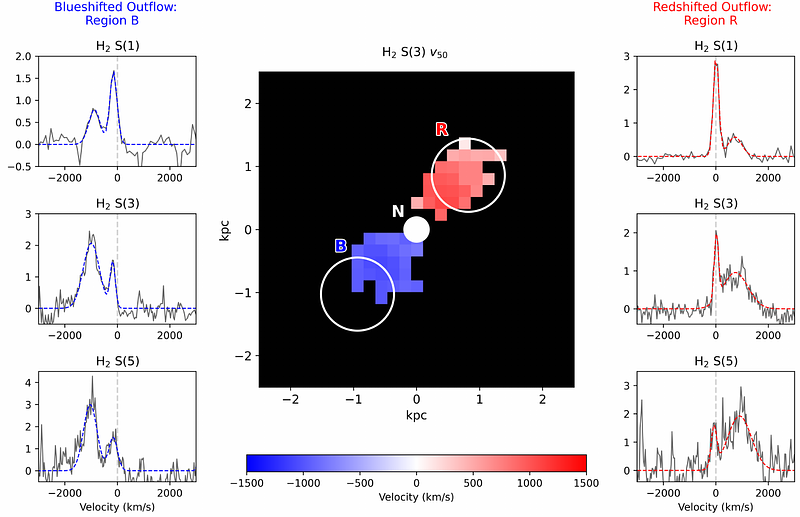JWST Discovery of a Very Fast Biconical Outflow of Warm Molecular Gas in the Nearby Ultra-Luminous Infrared Galaxy F08572+3915 NW

JWST Discovery of a Very Fast Biconical Outflow of Warm Molecular Gas in the Nearby Ultra-Luminous Infrared Galaxy F08572+3915 NW
Kylie Yui Dan, Jerome Seebeck, Sylvain Veilleux, David Rupke, Eduardo Gonzalez-Alfonso, Ismael Garcia-Bernete, Weizhe Liu, Dieter Lutz, Marcio Melendez, Miguel Pereira Santaella, Eckhard Sturm, Francesco Tombesi
AbstractWe present new James Webb Space Telescope (JWST) Mid-Infrared Instrument (MIRI) Medium-Resolution Spectrometer (MRS) observations of the nearby ultra-luminous infrared galaxy (ULIRG) F08572+3915 NW. These integral field spectroscopic (IFS) data reveal a kpc-scale warm-molecular rotating disk and biconical outflow traced by the H$_2$ $\nu$ = 0$-$0 S(1), S(2), S(3), and S(5) rotational transitions. The outflow maintains a relatively constant median (maximum) projected velocity of 1100 km s$^{-1}$ (3000 km s$^{-1}$) out to $\sim$ 1.4 kpc from the nucleus. The outflowing H$_2$ material is slightly warmer (640 $-$ 700 K) than the rotating disk material (460 $-$ 520 K), perhaps due to shock heating in the highly turbulent outflowing material. This outflow shares the same kinematics and orientation as the sub-kpc scale warm-H$_2$ outflow traced by the ro-vibrational H$_2$ lines in Keck AO near-infrared IFS data. However, this warm-H$_2$ outflow is significantly faster than the sub-kpc scale cold-molecular outflow derived from multi-transition far-infrared OH observations with Herschel and the $\gtrsim$ kpc-scale cold-molecular outflow mapped by mm-wave interferometric CO 1$-$0 observations with IRAM-PdBI and NOEMA. The new JWST data bolster the scenario where the buried quasar in this ULIRG is excavating the dust screen, accelerating perhaps as much as 60\% of the dusty warm-molecular material to velocities beyond the escape velocity, and thus influencing the evolution of the host galaxy.